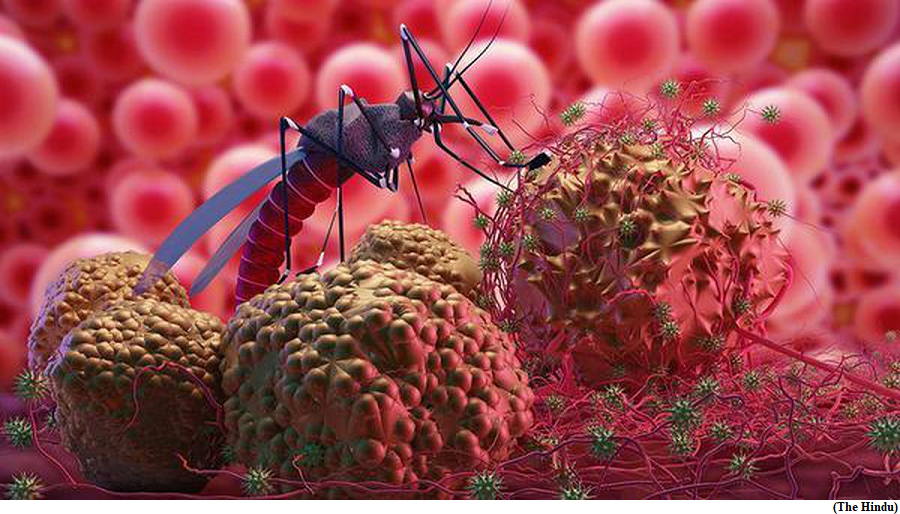In 2022, 66 percentage of malaria cases in Southeast Asia were from India (GS Paper 2, Health)

Why in news?
- In 2022, India accounted for 66% of malaria cases in the WHO Southeast Asia Region, as per the World Malaria Report, 2023, published by the World Health Organization (WHO).
- It adds that almost 46% of all cases in the region were due to Plasmodium vivax, a protozoan parasite and human pathogen which is the most frequent and widely distributed cause of recurring malaria.
Key Highlights:
- The report highlights that despite strides in expanding access to insecticide-treated nets and medicines to help prevent malaria in young children and pregnant women, more people were getting sick with malaria.
- The WHO Southeast Asia Region accounted for about 2% of malaria cases globally, while malaria cases declined by 76% from 23 million in 2000 to about five million in 2022.
- Malaria case incidence in this region decreased by 83%, from about 18 cases per 1,000 population at risk in 2000 to about three cases per 1,000 population at risk in 2022.
- Giving the global picture and trends in malaria, the report stated that in 2022, there were an estimated 249 million cases globally, exceeding the pre-pandemic level of 233 million in 2019 by 16 million cases.
Factors responsible:
- In addition to the disruptions caused by COVID-19, the global malaria response has faced a growing number of threats, such as drug and insecticide resistance, humanitarian crises, resource constraints, climate change impacts and delays in programme implementation particularly in countries with a high burden of the disease, said the report, which also delves into the link between climate change and malaria.
- The changing climate poses a substantial risk to progress against malaria, particularly in vulnerable regions.
Way Forward:
- A substantial pivot in the fight against malaria is needed, with increased resourcing, strengthened political commitment, data-driven strategies and innovative tools.
- Innovation should focus on the development of more efficient, effective and affordable products.
Six exoplanets found orbiting a nearby bright star
(GS Paper 3, Science and Technology)
Why in news?
- Six exoplanets orbiting around a nearby bright star (HD 110067) in the Coma Berenices constellation has been discovered.
- The planets have radii between that of Earth and Neptune.
- A study has calculated the orbit details, along with estimates of their masses and densities, which offer clues about the formation of the system and compositions of the planets’ atmospheres.

HD 110067:
- Planets with radii between that of the Earth and Neptune (referred to as ‘sub-Neptunes’) are found in close-in orbits around more than half of all Sun-like stars, but details of their composition, formation and evolution are not well understood.
- HD 110067 is a bright star in the Coma Berenices constellation (around 100 light-years away), which is visible from Earth’s Northern Hemisphere.
- Observations of HD 110067 made by NASA’s Transiting Exoplanet Survey Satellite (TESS) in 2020 and 2022 revealed several dips in the star’s brightness, and with additional observations from the ‘CHaracterising ExOPlanets Satellite’ (CHEOPS) the signals were interpreted as six planets passing in front of the star.
Key Highlights:
- By studying the three innermost planets, the authors calculated the orbits of all six planets, ranging from around nine days for the innermost planet to around 54 days for the outermost planet.
- They have calculated the masses of the planets and estimate the densities, which are relatively low; the authors suggest that the low densities could be explained by large, hydrogen-rich atmospheres.
- All six planets are in resonant orbits, in which the planets exert regular forces on each other as they orbit. This feature suggests that the system remains practically unchanged since its birth, at least four billion years ago.
Conclusion:
- HD 110067 is the brightest star found to host more than four transiting exoplanets to date, the authors note, and add that more planets may exist within or beyond the temperate zone, although such observations have not been made so far.
- They conclude that the HD 110067 system offers a chance to learn more about sub-Neptunes and how systems in this configuration might form.
India re-elected to Int'l Maritime Organisation Council with highest tally
(GS Paper 2, International Organisation)
Why in news?
- India was re-elected to the International Maritime Organisation (IMO) Council with the highest tally at elections held at its assembly recently for the 2024-25 biennium.
- India's re-election falls under the Category of 10 states with "the largest interest in international seaborne trade", alongside Australia, Brazil, Canada, France, Germany, the Netherlands, Spain, Sweden and the United Arab Emirates (UAE).

About IMO:
- The IMO is the premier body that oversees the maritime sector, which in turn underpins international trade, transport and all maritime activities.
- The council is the executive organ of IMO and is responsible, under the assembly, for supervising the work of the organisation.
- Between sessions of the assembly, the council performs the functions of the assembly, except that of making recommendations to governments on maritime safety and pollution prevention.
3 Assembly of IMO:
- The 33rd Assembly of IMO is meeting at the IMO Headquarters in London between November 27 and December 6.
- All 175 member states and three associate members are entitled to attend the assembly, which is the IMO's highest governing body.
- The assembly normally meets once every two years in a regular session.
- It is responsible for approving the work programme, voting the budget and determining the financial arrangements of the organisation.
- It also elects the organisation's 40-member council at these meetings for the next two-year period.




